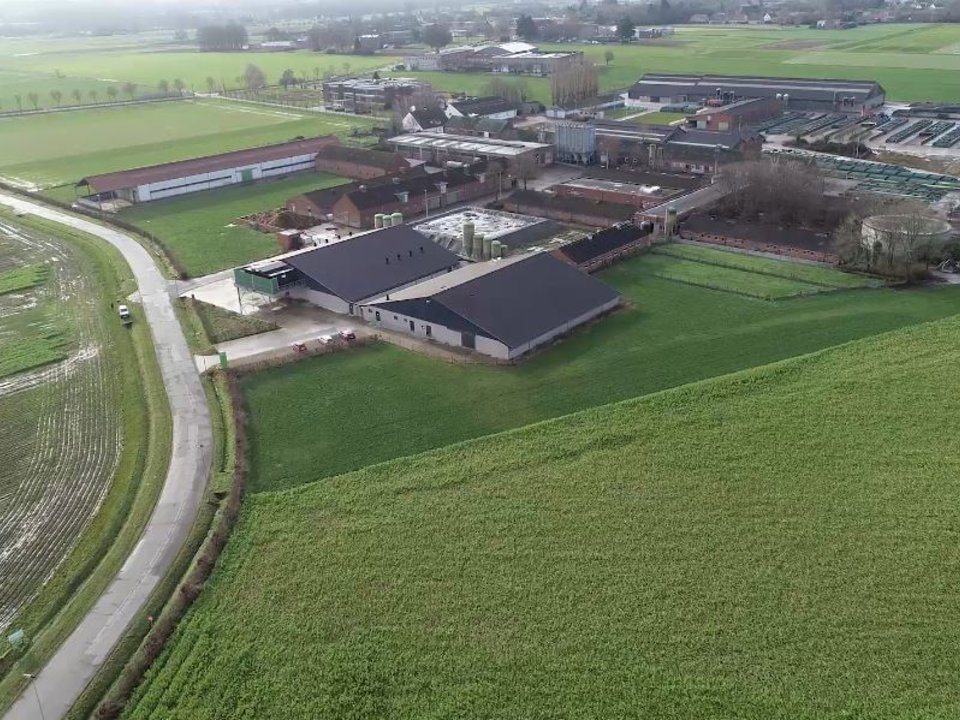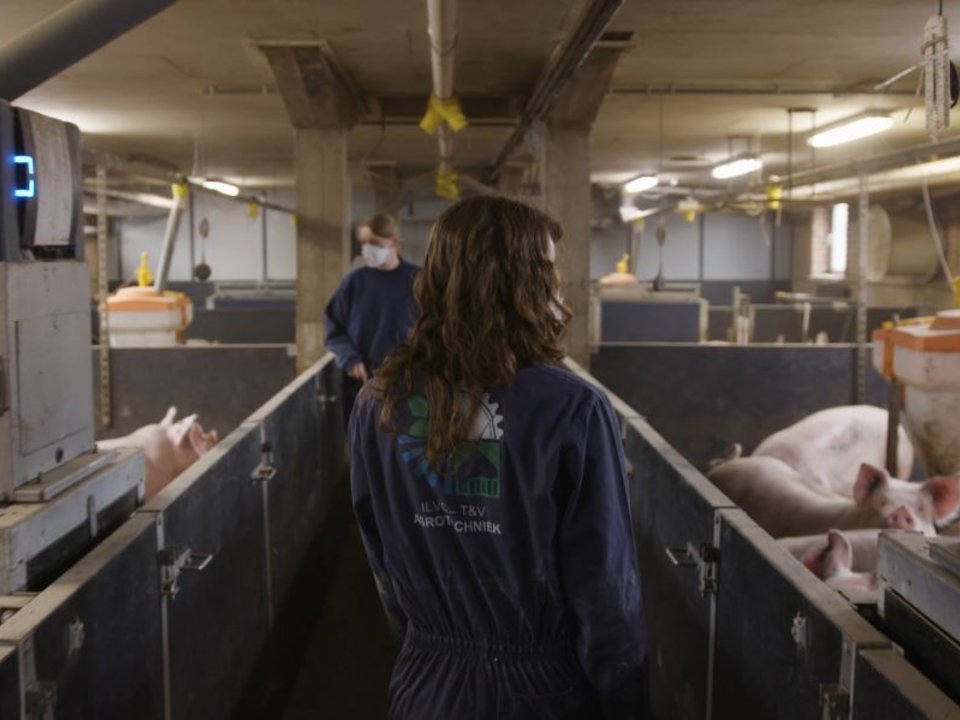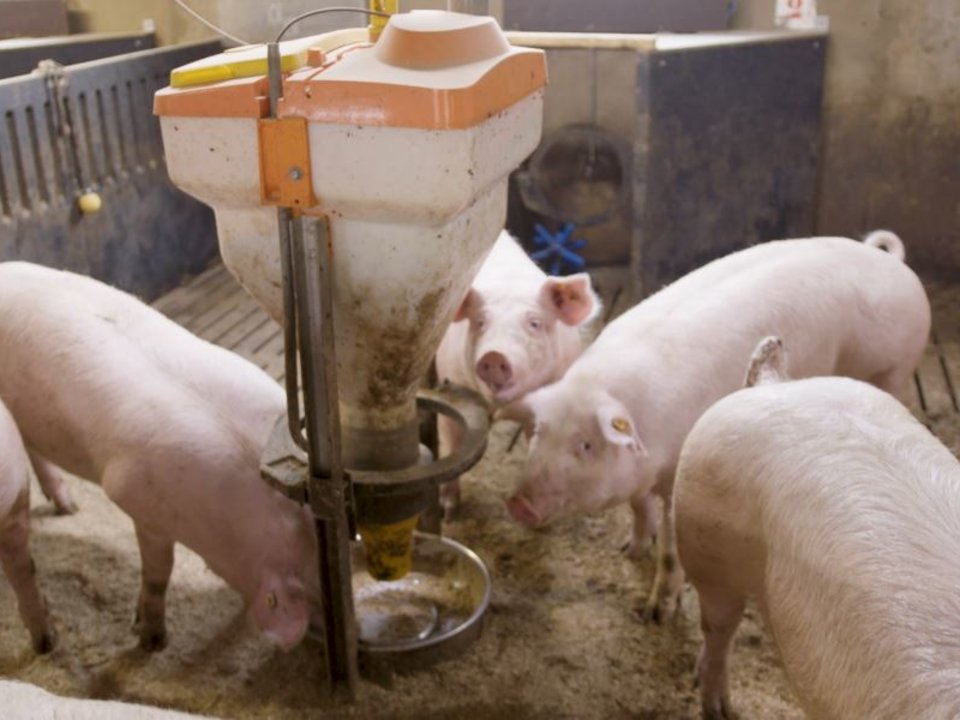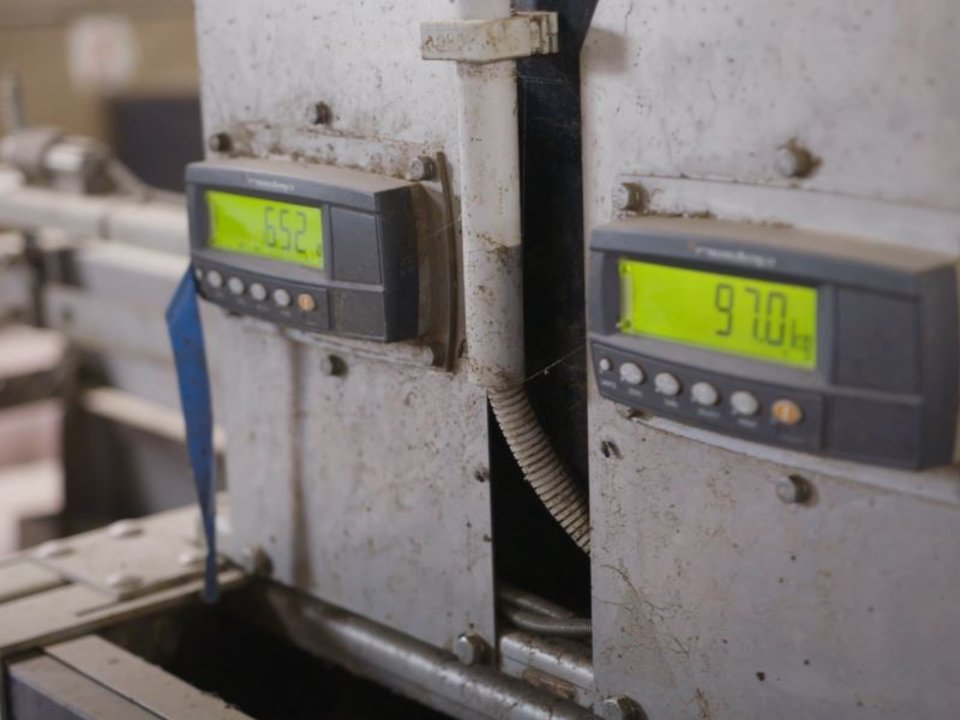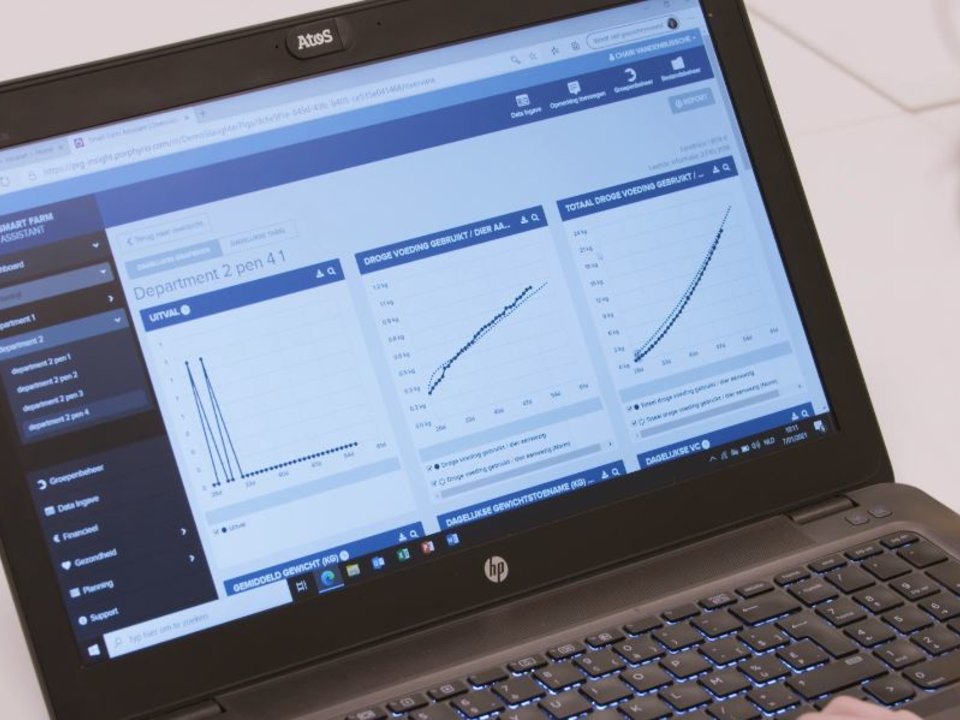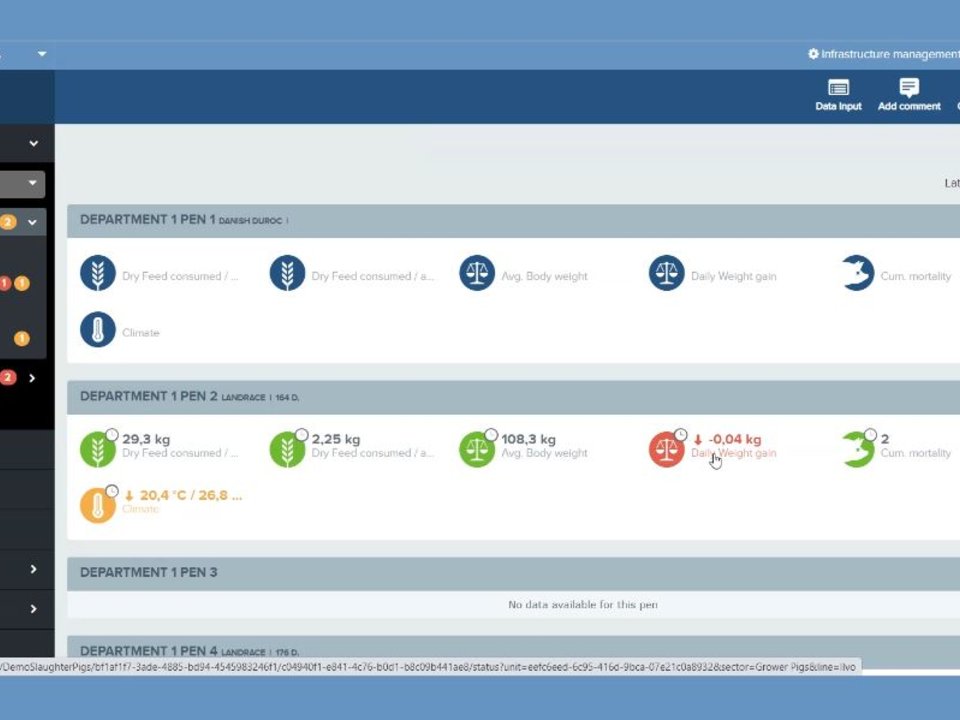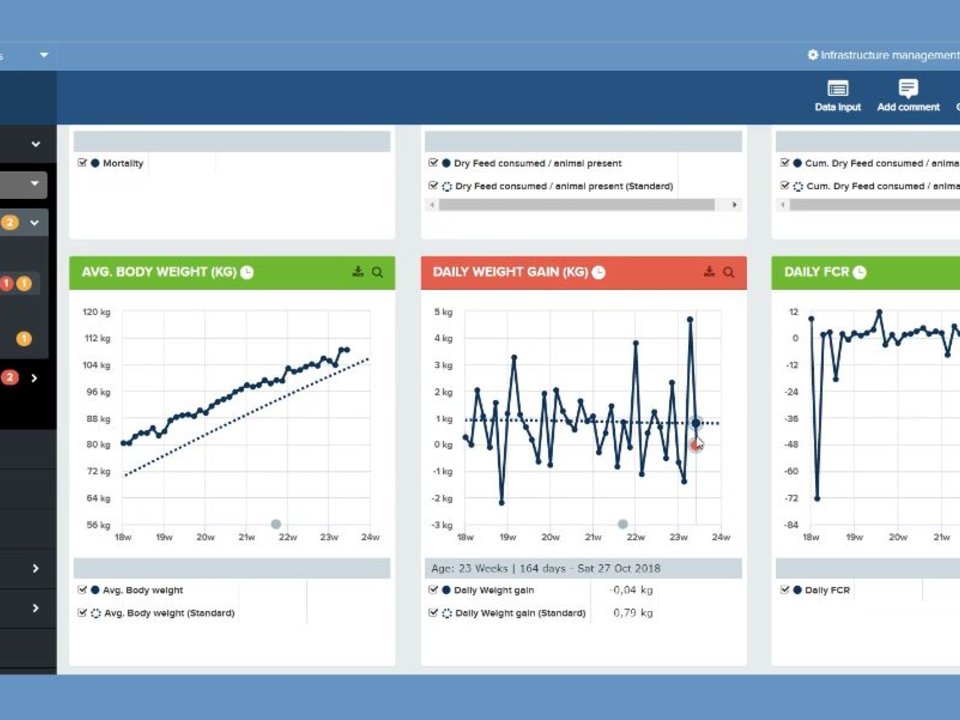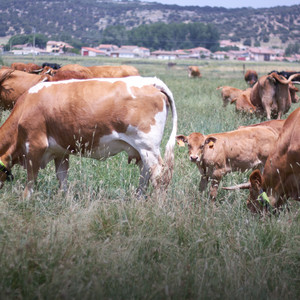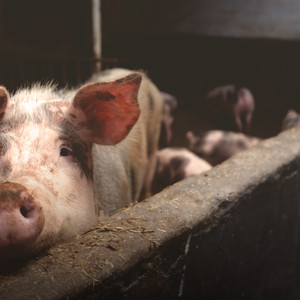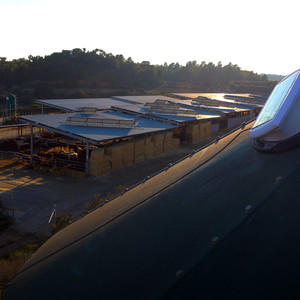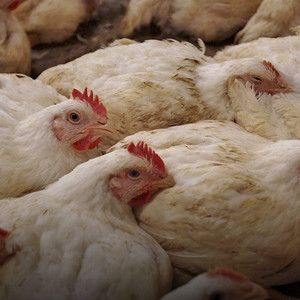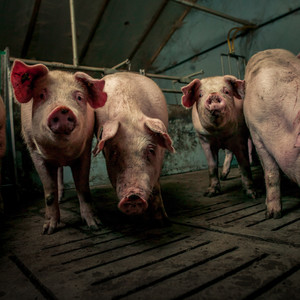Introduction
The demands for sustainable production in the competitive pig farming industry can only be met when the whole production chain from farm to fork becomes more efficient. To optimise the management of pig farms, data collection and analysis are key. This use case focuses on linking data across the value chain to provide the pig farmers with the necessary information to effectively implement and steer their management activities. Livestock farming based on data-driven decision-making is on the agenda more than ever for making agriculture more sustainable. The team is thus working on a smart data processing system that gathers and monitors the data of climate control systems in the barn, the consumption of water and feed and the growth of the pigs. These indicators are linked to each other and to the health of the pigs and have a major impact on the economy of the farm. Through farm-specific alert thresholds that evolve along with the age of the pigs, the pig farmer can be alerted if something goes wrong.
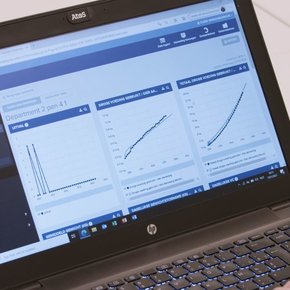
Generating added value from existing data
Jarissa Maselyne, the Use Case Coordinator and Researcher at ILVO, deployed the solution together with Evonik Porphyrio, Vion, ZLTO and LINKS Foundation on five fattening pig farms.
Show more
The team brings existing data streams on a pig farm together in one dashboard. Moreover, they enrich the dashboard with external data from the slaughterhouse and include data analysis, for example in light of boar taint prevention. They also focus on individual pig data and thereby detect those animals that, on certain days, came less for drinking or feeding. Combined with the health monitoring from the animal caretakers they could see a correlation between reduced feeding and drinking times with observed health impairment.
The most important aim of their research, however, is that the pig farmer experiences the developed system as being affordable and user friendly while based on a lot of already existing data. Concretely, the pig application means the following: the information obtained from climate control in the barn is brought together with weight data from the pigs and their feed and water consumption. All this information is collected using heterogeneous smart devices and legacy systems, which are integrated and made interoperable with each other, leveraging the LINKS IoT platform. This software stores the data in a database and forwards it to the dashboard, using open-source technologies, e.g., the FIWARE Orion Context Broker and the related security components. Thanks to the Porphyrio® dashboard, the pig farmer can graphically view the pattern of growth and consumption on a daily basis with just a few clicks while also monitoring the feed conversion. In addition to that, alerts are included. In the dashboard, the pig farmer receives an immediate warning if certain registered data are below or above the normal values and an intervention is required to ensure both the welfare of the animals and the productivity for the end-user. Providing such management information enables the farmers to improve the sustainability of their production (e.g. use of feed ingredients) and to create maximum added value, regarding intrinsic product quality such as boar taint reduction as well as extrinsic product characteristics like carbon footprint. Boar taint causes an unpleasant odour or taste that can be evident during the cooking or eating of pork products derived from non-castrated male pigs once they reach puberty. A significant part of consumers is sensitive to board taint, highlighting the necessity for pork producers to control it effectively.
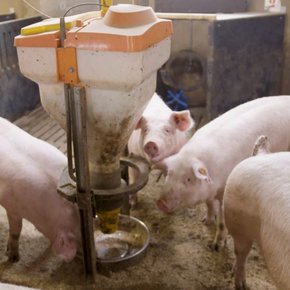
From group to individual level monitoring
Evonik Porphyrio developed a dashboard with an early warning system for the group level data in modern pig farming facilities. To guarantee the user-friendliness, whose importance we emphasised in the previous chapter, it is based on information already available on the farm.
Show more
Therefore, LINKS and Evonik Porphyrio brought their respective knowledge on data collection and early warning in poultry farming to the pig sector. After a data-availability audit to identify all available production data and how it can be collected, automatic collection procedures could be established. The aim was to centralise and standardise sensor registrations on which the dashboard and early warnings for the most important production parameters are based.
After the first development phase, the use case team demonstrated the group level dashboard and asked farmers for their feedback. One thing became clear: farmers need a top-down approach to capitalise on their existing farm data and thereby monitor and optimise existing practices. In an ideal case, a dashboard would show farm level data and department level data first. So far, leveraging pen level data is unusual in pig farming and the entire potential of it is thus untapped. Going over the data of all different pens in the barn on a daily basis would be too time consuming, but in combination with an early-warning system this is more practical and can give the farmers more insights. At last, a combination can be made of the slaughterhouse data and the live farm data that was collected during the fattening round of the slaughtered pigs to see the influence of the daily proceedings on farm on the slaughterhouse results.
+6% up to +8%
Average daily weight gain
-10%
Feed conversion ratio
Since systems that can help pig farmers to monitor their individual animals are not yet widely spread and little is known about the possible benefits of the systems, the use case team set out to change that. Their main motivation: a daily individual monitoring is needed to ensure the optimal welfare and productivity of each pig. At the same time, it gives farmers the possibility to use treatments only for the animals that actually need them. Also, the link between production information, boar taint and genetics is best done for the individual pig as there are large variations between pigs, even those coming from the same parents or the same department. Measuring daily feeding patterns, estimated feed intake and growth of individual finishing pigs in combination with data-analysis is of additional added value for the farmers in their daily management operations: daily problem detection, genetic selection, follow up of performance indicators, link between production results and management strategies, just to name a few. Therefore, the research partners are currently exploring the innovative individual monitoring of pigs. This is done with RFID tags in combination with sensors available on the market or prototypes focused on growth monitoring or drinking and feeding systems. Imagine what change could happen in the barn if the end-user is able to precisely monitor every single animal at any time. That means less medication, much more precise and individual care in a faster way as it is centralised in one dashboard.
To leverage the true potential of individual level data, algorithms for individual pig problem detection were developed and tested by the caretakers in the ILVO test barn. Towards the end of the research project, the caretakers tested the latest version of the individual warning system for half of the pigs in the barn while the other half served as reference. After that, the algorithms were updated and are now being tested by the caretakers again for further improvement.
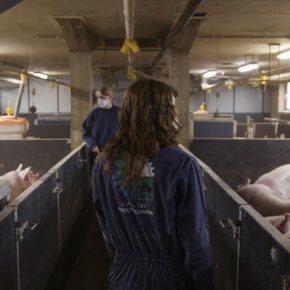
Traceability and consumer perception
The socio-economic impact of this use case was to investigate how consumers feel about the use of IoT technologies to assist the farmer with the monitoring of the welfare of the livestock and their willingness to pay an additional price for this extra supervision.
Show more
Consumers received a number of general questions and then had to make a set of choices between three pieces of pork, each with slightly different characteristics regarding animal welfare label, use of technology on farm and price. This allowed the team to evaluate the perception and added value of enhanced monitoring on farm. Through the survey they learned that consumers greatly value animal welfare. However, although the utility of additional monitoring of the pigs through technology was clear to the consumers, the results indicated that they were not yet willing to reward this additional information with a higher price. The results confirm that there is a need for fundamental education of consumers to create attitudes and behaviours favouring the use of technology to promote sustainable development and animal welfare.
-20%
boar taint
-10%
Animal health incidences
-10%
Pig mortality
The investigation of the supply chain data showed that farmers are generally aware of the slaughterhouse results, but they do not have the tools to easily analyse trends over time or link management decisions with these results. Additionally, linking of groups of pigs or even individual pigs with their respective slaughterhouse results is very labour intensive and thus not often performed by the farmers. However, farmers that invest more time in the tracking of animals and data from the barn to the slaughterhouse get more valuable insights from extra analysis and are better able to pinpoint problems that occurred during the production. Interoperability of existing system is still a major obstacle in achieving this. Therefore, the use case team focused on the promotion of open standard initiatives like smart data models. In these regards, the researchers have collaborated with the meat use case Meat Transparency and Traceability to finalise the work of integration between Next Generation Services Interface (NGSI) and Electronic Product Code Information Service (EPCIS) standards. Thanks to this collaboration a solution to integrate the data sent through the FIWARE Orion Context Broker and the EPCIS systems has been released. NGSI is a standard for data exchange currently promoted by the FIWARE foundation in Europe and used in large European research and innovation projects, while EPCIS is a standard to store and use information on products in many business situations, including perishable goods such as meat in supply chains.
With all these efforts this use case confirms that data in the agricultural chain offer added value for various stakeholders in the chain and improve the interaction between them. Moreover, leveraging data provides the farmer with a clear economic and time-saving advantage by following up on key performance indicators. Ultimately, this also increases animal welfare and the sustainability of agriculture as a whole. Let us thus reiterate: data-driven decision-making is more than ever on the agenda concerning the sustainability of livestock production.

Get in touch with the use case team via the SmartAgriHubs Innovation Portal
Go to portalAchievements, products & services
Pig business intelligence dashboard
Combining data across the pig farm in one handy tool (climate, feed, water and weighing systems)
Compatible with a wide range of systems from different suppliers
Early warnings and predictions to steer the farm in real-time
Exploration of individual pig health monitoring

